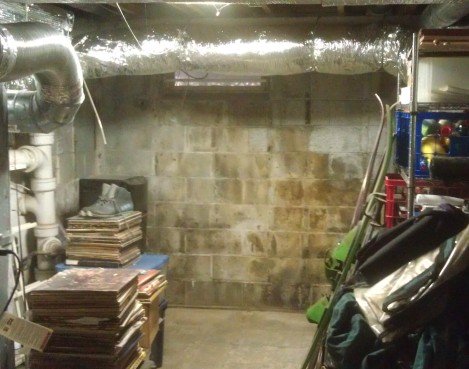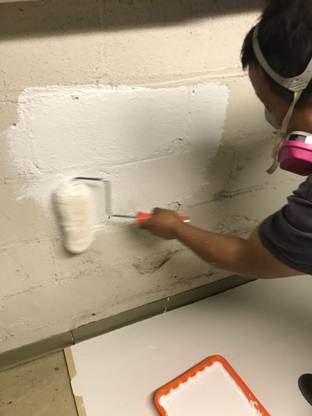Find a Mold Specialist Now
Click or Call, Toll-Free 24/7
How To Waterproof Your Basement
If your basement is damp and musty smelling due to moisture, how do you waterproof your basement so that you can be assured that your home and your possessions don’t get ruined? A basement can be an extremely useful area of your home unless it is constantly damp and smelly. There are several options to consider when it comes to how to waterproof a basement.
Some Things to Consider
- Never ignore a musty odor in your basement; the problem will not solve itself.
- Take immediate action to stop any inflow of water or to eliminate higher than normal humidity issues.
- Before any remodeling or finishing of your basement, determine if the basement is consistently damp for any reason, and find out what is causing the issue.
 Basement wall with mold
Basement wall with moldDiverting Outside Water
You should begin any waterproofing project for your basement by making sure water doesn’t collect and lay around the outside of your home’s foundation. Soil grading is vitally important to maintaining a dry basement. Dirt should be at least 6 inches below the sill plate (where wood meets the concrete foundation) and graded so that water flows away from the building, sloping two inches for every foot that you move away from the foundation, for a distance of at least ten feet.
Make sure your gutters are firmly attached to your home and free of debris with periodic cleanings, especially as summer ends and leaves begin to fall. Also check the downspouts for clogs. Make sure that the downspouts are directed away from the house by a distance of at least five feet. Use splash blocks or downspout extensions to move the water away (An easy way to check that your downspouts are free of clogs is to use a garden hose to flush water down them. If the water flows easily, the downspouts are clear).
Plants, bushes and trees should never be planted closer to the foundation than three feet. Their root systems could hold water against the foundation. If any plantings are too close you should consider relocating them to a spot a little further away. Also, as dead plant roots deteriorate and rot away, they can leave channels that may allow water to collect around your foundation.
How to Waterproof Your Basement on the Inside
If your basement is unfinished, or before you finish any areas, consider applying two coats of a basement concrete sealer. Make sure the sealer is a penetrating variety as these types of sealers provide better waterproofing results. It is usually suggested that you apply at least two coats of sealer, allowing the first application to dry at least two hours before applying the second coat.
If your basement doesn’t already have a sump pump, consider having one installed. This is great for protection whether you have a finished basement or not. If your basement already has a sump pump, check to ensure that it not only is plugged in and runs, but that it empties the crock of water. An easy way to do this is to periodically dump a five-gallon bucket of water into the crock. The pump should come on and pump the water out. If it starts pumping but doesn’t empty the crock quickly, there may be an obstruction in the pipe that carries the water outside. Also, you should make sure that, like your downspouts, the water is carried at least five feet away from the home’s foundation.
Because basements are below grade rooms, excess humidity can be a problem. Any time warm, moist air comes into contact with cooler dry surfaces, condensation can take place.
If you are not sure if any amount of moisture is condensation or a leak, you can tape a piece of plastic wrap over the wet area. Seal all four sides of the plastic wrap with duct tape or blue painter’s tape for a couple of days. If moisture reappears on the outside of the plastic wrap, you have a condensation problem. If the moisture forms on inside, between the plastic wrap and the wall, there’s a leak.
A home’s comfortable and safe relative humidity levels usually falls somewhere between 30 to 45 percent (expressed as 30%-45% RH). Relative humidity levels that are too low can cause discomfort for humans and do damage to wood furniture. Relative humidity levels that are too high can lead to microorganism (mold) growth. To combat above normal relative humidity levels you should run a small dehumidifier in your lower level. You should buy one that is rated to remove at least 30 pints of water per day. Also, to simplify your life a little more, purchase a dehumidifier that has an automatic pump out feature or at least a drain line that you can hook a hose up to. That way it’s operation will be more automatic and you won’t have to worry about the reservoir filling up and turning off until you empty it.
Search for any cracks in your basement’s concrete walls or floor. Any cracks can be places where water can enter your basement, especially if the crack is more than just a hairline crack. Cracks should be sealed with a specifically designed basement crack sealer. After sealing any cracks you can option to apply a waterproofing paint that will further insure that no moisture will be able to enter.
The Importance of Waterproofing Your Basement
Whether your basement is finished or unfinished and used as a convenient place for storage, it’s important to have a dry, moisture-free basement. Wet or damp basements can lead to problems with your home’s structural integrity (foundation cracks, mortar cracks, bowing of exterior walls). At the same time, basements that are constantly damp or wet can become a breeding a ground for molds that may cause health problems (respiratory problems, skin irritations, asthma-like symptoms) for people and pets living in the home.
If you have a wet basement or see mold growing in it, you can get a list of local experts that will give your home a free inspection. The experts on our list are pre-screened and pre-qualified. They can advise you of your options, make recommendations, and provide a free, no-obligation estimate for any needed repairs.
Return From How To Waterproof Basement To Our Main Prevention Page
Written by Mark Huey.
Privacy Policy Terms and Conditions Accessibility Do Not Sell My Information Disclaimer Contact Us





